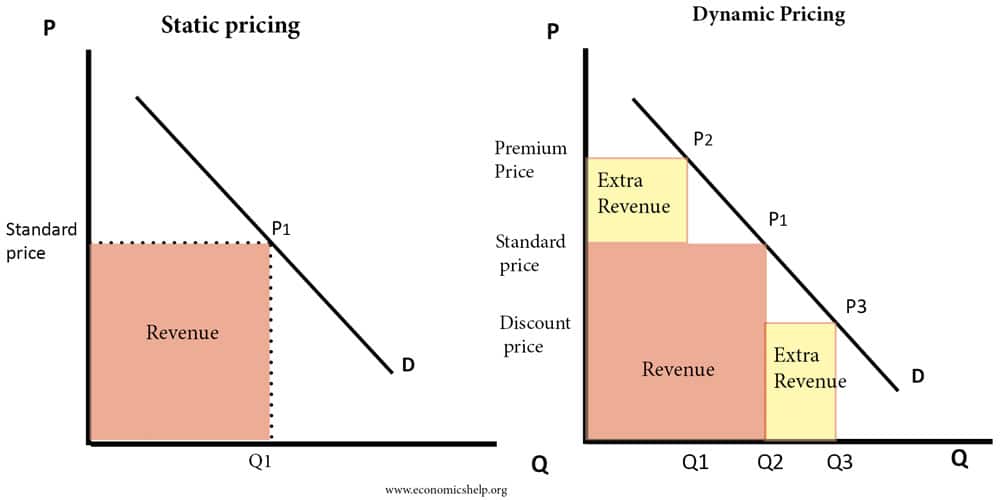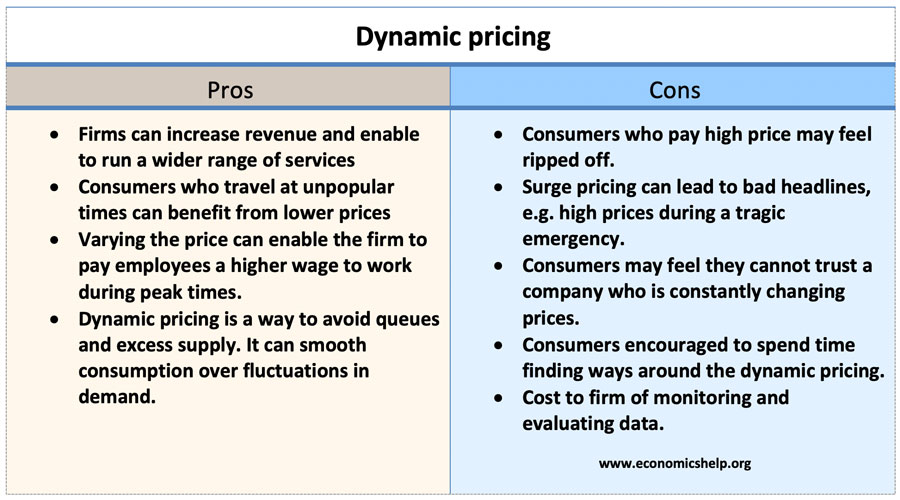Dynamic pricing is a method firms use to constantly adjust the price of goods/services depending on demand. For example, if there is a surge in demand, firms respond to the market data by increasing price. New technology has increased the scope for more variable dynamic pricing, and it is increasingly used by companies, such as airlines, taxi companies and hotels. Dynamic pricing enables a firm to set multiple different prices and maximise total revenue.
Dynamic pricing requires
- A degree of market power in setting prices
- Consumers with different elasticities of demand and willingness to pay
- An ability for the firm to be aware of how demand fluctuates
- Prevent reselling between the different prices.

This is a simplified version of dynamic pricing. On the left, is a simple static price – a standard taxi fare to the centre of a city. However, at peak time, the firm could charge a premium price because demand is more price inelastic. For quiet periods, the firm could offer a discount price to encourage greater consumption. Overall the firm increases revenue. This works like standard price discrimination.
Development of technology
Modern technology allows much more sophisticated forms of dynamic pricing because the company can view real-time data. For example, if there is a bus strike on one particular day, demand will surge, and the company can raise prices instantly.
For a taxi firm, the increase in price during a period of surge demand can have a dual benefit – not only does it maximise revenue, but it also creates an incentive for taxi drivers to work during these busy moments. With dynamic pricing, customers are more likely to get taxis during popular times, though they would have to pay a higher price for the privilege.
Airlines increasingly use dynamic pricing to manage demand between different flights. If a flight is nearly booked up several months before the date, the company can increase the price to maximise revenue from the last few seats. Equally, if an unpopular time of the day is selling slowly, the firm can cut price. The advantage is that the firm is not stuck with inflexible prices but can deal with unexpected surges in demand.
Examples of dynamic pricing
- Price setting for Uber taxis – where the company advertises the price will vary depending on demand. Consumers are able to see the likely price they will pay before committing to the taxi.
- Tickets for professional sport. Major league baseball clubs have used dynamic pricing to set prices for seats. Demand varies depending on form, quality of opposition and other factors. For popular games, prices will rise.
- Price of flights Easyjet, Ryanair – prices are constantly being revised depending on how well they are selling.
- Google Ads. The price of paying for Google ads is determined by a marketplace supply and demand. Ads for competitive keywords will push up the price as there is more demand. If a keyword becomes less competitive, the price will fall.
- Electricity companies. Companies can vary the price of electricity depending on demand and supply. For example, in summer with greater supply from solar panels and less demand for heating, prices will fall. On cold days, prices can be increased.
Pros and cons of dynamic pricing

Advantages of dynamic pricing
- Firms can increase revenue and enable to run a wider range of services. Without dynamic pricing, it may be harder to get a taxi at a time of the day when taxi drivers don’t want to work.
- Consumers who travel at unpopular times can benefit from lower prices. If you know off-peak times will be cheaper, it can enable low-income consumers to consume a good; they otherwise wouldn’t have.
- Varying the price can enable the firm to pay employees a higher wage to work during peak times. This gives a benefit to employers, but equally, it can lead to lower wages during a slump in demand and greater uncertainty over wages.
- Dynamic pricing is a way to avoid queues and excess supply. It can smooth consumption over fluctuations in demand. The idea of Uber was that it would prevent periods where you couldn’t find a taxi.
Disadvantages of dynamic pricing
- Consumers who pay the higher price may feel ripped off.
- Surge pricing can lead to bad headlines, e.g. high prices during a tragic emergency.
- To combat these headlines, firms can place manual limits on the amount prices surge by.
- Consumers may feel they cannot trust a company who is constantly changing prices. This could harm market share in the long-term.
- Consumers encouraged to spend time finding ways around the dynamic pricing.
- Cost to the firm of monitoring and evaluating data.
Related
